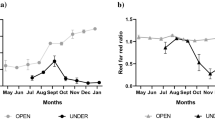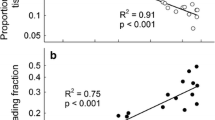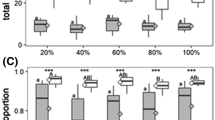Abstract
Many woodland herbs are long-lived, clonal geophytes that have evolved life histories favoring survival over reproduction. We examined the life history responses of natural populations of two woodland orchid species,Cypripedium calceolus andCephalanthera longifolia to defoliation and heavy shading conducted early in the growing seasons of 2002 and 2003. We asked whether, in view of the importance of growth for the survival of geophytes, treated plants were more likely to exhibit reduced flowering than reduced vegetative growth in the seasons following treatment. We also asked whether plants would suffer reduced ramet performance. Both treatments led to significant declines in flower number per ramet, number of leaves per ramet, and mean ramet height relative to controls inCypripedium. However, inCephalanthera, only shaded plants exhibited significant declines in flower number per ramet, and only defoliated plants exhibited declines in mean ramet height. The number of ramets per plant did not decline relative to controls in either species. Thus, these orchids, especiallyCypripedium, appeared to allocate resources preferentially to vegetative growth functions over sexual reproduction. Per-plant variation in leaf and flower number per ramet, as well as in mean ramet height, consistently declined in response to treatment, significantly so in the case of mean ramet height, suggesting that ramets became more similar within genets. These results suggest both similarities and differences in the ways in whichCephalanthera andCypripedium mobilize resources in response to stress.
Similar content being viewed by others
References
Amundsen T. &Slagsvold T. (1998): Hatching asynchrony in great tits: a bet-hedging strategy?Ecology 79: 295–304.
Baltzer J.L., Reekie E.G., Hewlin H.L., Taylor P.D. &Boates J.S. (2002): Impact of flower harvesting on the salt marsh plantLimonium carolinianum.Canad. J. Bot. 80: 841–851.
Callaghan T.V., Carlsson B.Å., Jónsdóttir I.S., Svensson B.M. &Jonasson S. (1992): Clonal plants and environmental change: introduction to the proceedings and summary.Oikos 63: 341–347.
Chesson P. &Peterson A.G. (2002): The quantitative assessment of the benefits of physiological integration in clonal plants.Evol. Ecol. Res. 4: 1153–1176.
Collins B.S. &Pickett S.T.A. (1988a): Demographic responses of herb layer species to experimental canopy gaps in a northern hardwoods forest.J. Ecol. 76: 437–450.
Collins B.S. &Pickett S.T.A. (1988b): Response of herb layer cover to experimental canopy gaps.Amer. Midl. Naturalist 119: 282–290.
Curtis J.T. (1943): Germination and seedling development in five species ofCypripedium LAmer. J. Bot. 30: 199–206.
Curtis J.T. (1954): Annual fluctuation in rate of flower production by native Cypripediums during two decades.Bull. Torrey Bot. Club 81: 340–352.
Curtis J.T. (1959):The vegetation of Wisconsin: an ordination of plant communities. University of Wisconsin Press, Madison.
Dafni A. &Ivri Y. (1981): The flower biology ofCephalanthera longifolia (Orchidaceae) - pollen limitation and facultative floral mimicry.Pl. Syst. Evol. 137: 229–240.
de Jong G. (1993): Covariances between traits deriving from successive allocations of a resource.Funct. Ecol. 7: 75–83.
de Kroon H., Whigham D.F. &Watson M.A. (1991): Developmental ecology of mayapple: effects of rhizome severing, fertilization and timing of shoot senescence.Funct. Ecol. 5: 360–368.
Derner J.D. &Briske D.D. (1998): An isotopic (N-15) assessment of intraclonal regulation in C-4 perennial grasses: ramet interdependence, independence or both?J. Ecol. 86: 305–314.
Fuller A.M. (1933): Studies on the flora of Wisconsin. Part I: The orchids;Orchidaceae. Bull. Public Mus. Milwaukee 14: 1–284.
Gaillard J.-M. &Yoccoz N.G. (2003): Temporal variation in survival of mammals: a case of environmental canalization?Ecology 84: 3294–3306.
Garcia M.B. &Ehrlén J. (2002): Reproductive effort and herbivory timing in a perennial herb: fitness components at the individual and population levels.Amer. J. Bot. 89: 1295–1302.
Glazier D.S. (2002): Resource-allocation rules and the heritability of traits.Evolution 56: 1696–1700.
Hutchings M. (1999): Clonal plants as cooperative systems: benefits in heterogeneous environments.Pl. Spec. Biol. 14: 1–10.
Kull T. (1987): Population ecology ofCypripedium calceolus L. In:Laasimer L. &Kull T. (eds.),The plant cover of the Estonian SSR: flora, vegetation, and ecology, Valgus, Tallinn, pp. 77–83.
Kull T. (1999):Cypripedium calceolus L.J. Ecol. 87: 913–924.
Kull T. (2002): Population dynamics of north temperate orchids. In:Kull T. &Arditti J. (eds.),Orchid biology, reviews and perspecitves 8, Kluwer Academic Publishers, Dordrecht, pp. 139–165.
Kull T. &Kull K. (1991): Preliminary results from a study of populations ofCypripedium calceolus in Estonia. In:Wells T.C.E. &Willems J.H. (eds.),Population ecology of terrestrial orchids, SPB Academic Publishing, The Hague, pp. 69–76.
Kull T. &Tuulik T. (1994): Orchid studies on permanent plots. In:Kull T. (eds.),Orchid ecology and protection in Estonia, Tartu University Press, Tartu, pp. 35–42
Lesica P. &Steele B.M. (1994): Prolonged dormancy in vascular plants and implications for monitoring studies.Natural Areas J. 14: 209–212.
Li R., Werger M.J.A., de Kroon H., During H.J. &Zhong Z.C. (2000): Interactions between shoot age structure, nutrient availability and physiological integration in the giant bambooPhyllostachys pubescens.Pl. Biol. 2: 437–446.
Marshall C. &Price E.A.C. (1997): Sectoriality and its implications for physiological integration. In:de Kroon H. &van Groenendael J. (eds.),The ecology and evolution of clonal plants, Backhuys Publishers, Leiden, pp. 79–107.
McKendrick S.L. (1996): The effects of shading on seedlings ofOrchis morio andDactylorhiza fuchsii in chalk and clay soil.New Phytol. 134: 343–352.
Metzger F. &Schultz J. (1984): Understory response to 50 years of management of a northern hardwood forest in upper Michigan.Amer. Midl. Naturalist 112: 209–223.
Primack R.B., Miao S.L. &Becker K.R. (1994): Costs of reproduction in the pink lady’s slipper orchid (Cypripedium acaule): defoliation, increased fruit production, and fire.Amer. J. Bot. 81: 1083–1090.
Reekie E.G., Budge S. &Baltzer J.L. (2002): The shape of the trade-off function between reproduction and future performance inPlantago major andPlantago rugelii.Canad. J. Bot. 80: 140–150.
Ruiz N., Ward D. &Saltz D. (2002): Responses ofPancratium sickenbergeri to simulated bulb herbivory: combining defence and tolerance strategies.J. Ecol. 90: 472–479.
Sather B.-E. &Bakke O. (2000): Avian life history variation and contribution of demographic traits to the population growth rate.Ecology 81: 642–653.
Shefferson R.P., Sandercock B.K., Proper J. &Beissinger S.R. (2001): Estimating dormancy and survival of a rare herbaceous perennial using mark-recapture models.Ecology 82: 145–156.
Silvertown J., Franco M., Pisanty I. &Mendoza A. (1993): Comparative plant demography — relative importance of life-cycle components to the finite rate of increase in woody and herbaceous perennials.J. Ecol. 81: 465–476.
Slatkin M. (1974): Hedging one’s evolutionary bets.Nature 250: 704–705.
Stancato G.C., Mazzafera P., &Buckeridge M.S. (2001): Effect of a drought period on the mobilisation of non-structural carbohydrates, photosynthetic efficiency and water status in an epiphytic orchid.Pl. Physiol. Biochem. 39: 1009–1016.
Stowe K.A., Marquis R.J., Hochwender C.G. &Simms E.L. (2000): The evolutionary ecology of tolerance to consumer damage.Annual Rev. Ecol. Syst. 31: 565–595.
Stuefer J.F., de Kroon H. &During H.J. (1996): Exploitation of environmental heterogeneity by spatial division of labour in a clonal plant.Funct. Ecol. 10: 328–334.
Summerhayes V.S. (1968):Wild orchids of Britain. Collins, London.
Sutherland W.J. &Stillman R.A. (1988): The foraging tactics of plants.Oikos 52: 239–244.
Tutin T.G. et al. (eds.) (1968–1993):Flora europaea Ed. 1, 2. Cambridge University Press, Cambridge.
van der Meijden E., de Boer N.J. &van der Veen-van WijkC.A.M. (2000): Pattern of storage and regrowth in ragwort.Evol. Ecol. 14: 439–455.
Whigham D. &Chapa A. (1999): Timing and intensity of herbivory: its influence on the performance of clonal woodland herbs.Pl. Spec. Biol. 14: 29–37.
Whigham D.F. (2004): Ecology of woodland herbs in temperate deciduous forests.Annual Rev. Ecol. Evol. Syst. 35: 583–621.
Willems J.H., Balounová Z. &Kindlmann P. (2001): The effect of experimental shading on seed production and plant survival ofSpiranthes spiralis (Orchidaceae).Lindleyana 16: 31–37.
World Conservation Union (1963):The Convention on International Trade in Endangered Species of Wild Fauna and Flora. The World Conservation Union (IUCN), Gland.
Author information
Authors and Affiliations
Corresponding author
Rights and permissions
About this article
Cite this article
Shefferson, R.P., Kull, T. & Tali, K. Demographic response to shading and defoliation in two woodland orchids. Folia Geobot 41, 95–106 (2006). https://doi.org/10.1007/BF02805264
Received:
Revised:
Accepted:
Issue Date:
DOI: https://doi.org/10.1007/BF02805264
Keywords
- Cephalanthera longifolia
- Cypripedium calceolus
- Geophytes
- Life history trade-offs
- Perennials
- Orchidaceae
- Resource allocation




